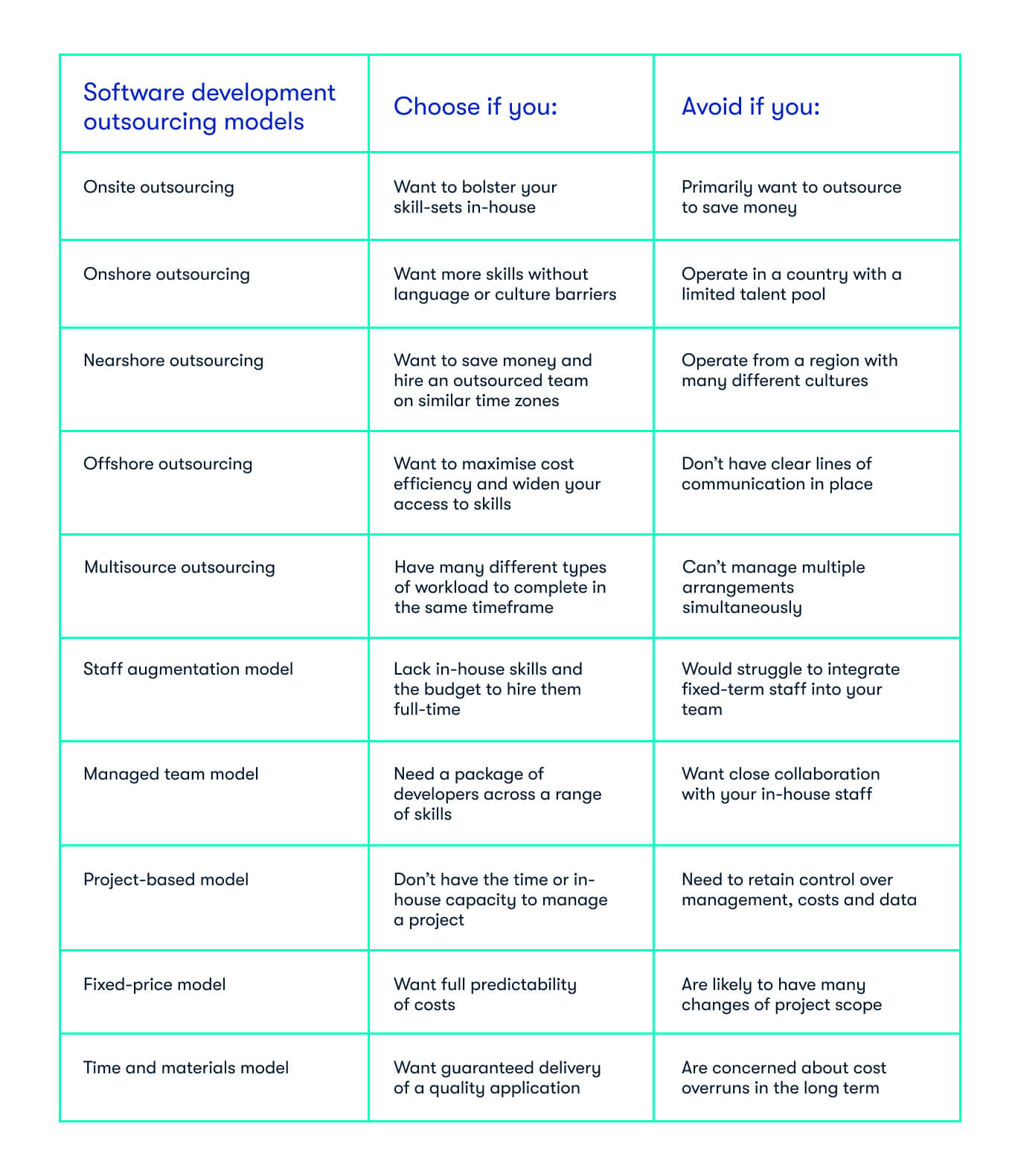Choosing new software development outsourcing models depends on so many factors and influences, as well as the specific problems you need to solve within certain parameters. But how can you make the right decision for your next project? This guide presents the different outsourcing models and their pros and cons so you can choose the best for your business.
Table of Contents
1. Types of Software Development Outsourcing Models
2. Location-based Software Development Outsourcing Models
3. Relationship-based Software Development Outsourcing Models
4. Contract-based Software Development Outsourcing Models
5. Which Outsourcing Model Suits Your Business Tasks and Values?
Types of Software Development Outsourcing Models
There are several different types of software development outsourcing models, which can be broadly grouped into the following three categories, depending on the main priorities of the client:
1. Location-based:
this is where decisions around outsourcing are made primarily on geographical and economic factors. For example, it can be much cheaper to hand work to an outsourced team in another part of the world where accessing expertise can deliver significant cost efficiencies.
2. Relationship-based:
under this arrangement, different set-ups are explored depending on the status of the relationship between the client and the outsourcing company involved. In particular, whether the outsourced team is considered part of the in-house business, or whether it exists as a separate entity, has to be worked out.
3. Contract-based:
this revolves around how the outsourcing company is paid and for what. This can either be through a fixed price, or a more flexible approach depending on the amount of time and materials consumed by project requirements.
Location-Based Software Development Outsourcing Models
With location-based software development outsourcing models, the key question a business like yours has to answer is just how close or far away they want their outsourcing partner to be.
Onsite Outsourcing
Under the onsite outsourcing model, a team is sent to work from your own premises for however long you need them. They are still employed by the outsourcing company, meaning you don’t have to worry about employing them directly, onboarding and training, or any financial and tax implications of expanding your workforce. They’re also able to work more closely and get up to speed more quickly with your existing staff and culture.
Onshore Outsourcing
The onshore outsourcing model is defined as using an outsourced team in the same country as where you’re based. This doesn’t have to be in the same city or region, but gives you access to expertise without barriers around language, culture or time zones. While this is one of the simplest location-based outsourcing models on paper, it does limit you somewhat in terms of the talent and experience you can access, and can mean cost efficiencies are limited.
Nearshore Outsourcing
Nearshore outsourcing stretches the boundaries out a little further, giving you more access to expertise and cost efficiencies, but without adding practical difficulties like working several time zones apart. It generally involves deploying an outsourced team from a neighboring country, or one within the same region (for example, within the European Union where there is only a maximum of a two-hour time difference). However, it should be noted that cultural, linguistic and legal complexities may still be an issue, depending on the countries involved.
Offshore Outsourcing
Offshoring is where you farm out work to an outsourcing company that theoretically could be located anywhere else in the world. You can find substantial cost efficiencies this way, and pursue round-the-clock development as they may be able to work outside of your normal operating hours. This works best when partnering with an experienced, reputable outsourcing service that can be trusted to communicate clearly with you and handle your data and intellectual property with care and security. By the way, we have an entire guide explaining how offshoring can turbocharge your business growth.
Multisource Outsourcing
One of the great things about software development outsourcing models is that you don’t have to stick with just one. You’re completely free to use a mixture of all the models above, depending on the types of project you need help with, and how closely the outsourced team needs to work with your existing workforce. For example, you could recruit an onsite outsourcing company to assist you with your UX, but send your heavy-duty back-end development work to a more cost-effective outsourcing partner in Asia.
Relationship-Based Software Development Outsourcing Models
Understanding how an outsourced team will work with you is one of the most important parts of choosing from different software development outsourcing models. There are three common approaches in this area:
Staff Augmentation Model
Staff augmentation, also known as an extended team model, is where staff are hired from an outsourcing company to work within your in-house team. This could be highly beneficial as it can boost capacity, expertise and skill set. These additional staff can work on-site with your team or remotely, They also can be hired for a specific period of time or to work on a particular project. This also allows you to quickly spin up more capability without the time and expense of hiring and onboarding full-time employees.
However, the disadvantage of this model is that it can be challenging to integrate third-party teams with your in-house team, especially if they join mid-project. The staff augmentation model can be a great solution for businesses who look to reduce cost and fill any gaps in their expertise and skills quickly.
Managed Team Model
Under this outsourcing model, a dedicated development team is deployed to work on your specific project requirements exclusively for however long their services are required.
One of the biggest benefits of this model is that you can retain control of what the team does and when. It also allows you to access proven experience in a dedicated team model where strong working relationships have already been forged. The dedicated team model provides great flexibility which is great for long-term projects where changes in the project scope or requirements are expected.
Project-Based Model
Of the three relationship-based models mentioned here, this is the one that is the most ‘hands-off’ from your point of view. The Project-Based model is also a common outsourcing strategy that many businesses adopt. Under this model your software development partner manages and supervises the whole development process based on your requirements.
A great advantage of this model is that you don’t need to have much or any expertise in-house for the projects you want to pursue. You won’t have to be involved or worry about project management or technical issues related to the project. However, one of the downfalls with this model is if your development partner does not meet your project requirements. To prevent this it’s important to choose the right software company that you can trust.
If you want to know more you can check our guide on "How to choose a software company for your business in 2023".
Contract-based Models for Software Development Outsourcing
Another key factor to consider within software development outsourcing models is the nature of the contract involved, and what that means from a financial perspective. According to Zippia, 59% say that cost is their biggest reason for outsourcing, so maximising cost efficiencies is critical to get right.
Fixed-price model
This is where a total price for all relevant work, skills and delivery parameters of a development project are agreed in advance. This gives the benefit of avoiding cost overruns and giving you financial predictability, but may still result in you paying extra if the scope of your project starts to change substantially.
Time and materials model
Alternatively, you can adopt the time and materials model, where the outsourcing company keeps track of all the resources you use and then presents you with a total bill at the end. While this can result in costs rising more than you’d initially planned, it does make it far easier for the outsourced team to adapt to changing requirements. Furthermore, it ensures that no compromises have to be made in the development of a quality app.
Which Outsourcing Model Suits Your Business Tasks and Values?
Obviously, every application development project and business is different, so there are lots of factors that come into play when choosing among different software development outsourcing models. However, this table gives you a general summary of which ones are right for you - and which ones to avoid:

If you aren’t sure which software development outsourcing models are right for you, Ciklum can help. We’re a Niche Player in the Gartner Magic Quadrant for Custom Software Development Services, and we can identify and implement an outsourced team and arrangement that’s perfect for your needs. Get in touch with our team today.
Blogs


































